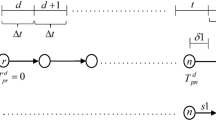Abstract
Based on the framework of method of successive averages (MSA), a modified stochastic user-equilibrium assignment algorithm was proposed, which can be used to calculate the passenger flow distribution of urban rail transit (URT) under network operation. In order to describe the congestion’s impact to passengers’ route choices, a generalized cost function with in-vehicle congestion was set up. Building on the k-th shortest path algorithm, a method for generating choice set with time constraint was embedded, considering the characteristics of network operation. A simple but efficient route choice model, which was derived from travel surveys for URT passengers in China, was introduced to perform the stochastic network loading at each iteration in the algorithm. Initial tests on the URT network in Shanghai City show that the methodology, with rational calculation time, promises to compute more precisely the passenger flow distribution of URT under network operation, compared with those practical algorithms used in today’s China.
Similar content being viewed by others
References
BEN-AKIVA M, LERMAN S R. Discrete choice analysis: Theory and application to travel demand [M]. Cambridge, Massachusetts: MIT Press, 1985: 31–57.
SMITH T E, HSU C C, HSU Y L. Stochastic user equilibrium model with implicit travel time budget constraint [J]. Transportation Research Record: Journal of the Transportation Research Board, 2008(2085): 95–103.
LIU Y L, BUNKER J, FERREIRA L. Transit users’ route-choice modeling in transit assignment: A review [J]. Transport Reviews, 2010, 30(6): 753–769.
LIU Tian-liang. A study on game equilibria and economic behaviors in transportation network with information provision [D]. Beijing: School of Economics and Management, Beijing Jiaotong University, 2008: 14–27. (in Chinese)
ZHU Wei. Research on the model and algorithm of mass passenger flow distribution in network for urban rail transit [D]. Shanghai: School of Transportation Engineering, Tongji University, 2011: 15–24. (in Chinese)
KATO H, KANEKO Y, INOUE M. Comparative analysis of transit assignment: Evidence from urban railway system in the Tokyo Metropolitan Area [J]. Transportation, 2010, 37(7): 775–799.
SHELFFI Y. Urban transportation networks: equilibrium analysis with mathematical programming methods [M]. Englewood Cliffs, Prentice-Hall, Inc, 1985: 312–341.
THOMAS R. Traffic assignment techniques [M]. Aldershot: The Academic Publishing Group, 1991: 32–46.
BELL M G H, IIDA Y. Transportation network analysis [M]. Chichester, West Sussex: John Wiley & Sons, 1997: 101–120.
CASCETTA E. Transportation systems analysis: models and applications [M]. New York, NY: Springer Science & Business Media, 2009: 43–51.
BEKHOR S, TOLEDO T. Investigating path-based solution algorithm to the stochastic user equilibrium problem [J]. Transportation Research Part B, 2005, 39(4): 279–295.
ZHANG T R, YANG C, CHEN D D. Modified origin-based algorithm for traffic equilibrium assignment problems [J]. Journal of Central South University, 2011, 18(5): 1765–1772.
SHEFFI Y, POWELL W B. An algorithm for the equilibrium assignment problem with random link times [J]. Networks, 1982, 12(2): 191–207.
LAM W H K, GAO Z Y, CHAN K S, YANG H. A stochastic user equilibrium assignment model for congested transit networks [J]. Transportation Research Part B, 1999, 33(6): 351–368.
FLYVBJERG B, HOLM M K S, BUHL S L. Inaccuracy in traffic forecasts [J]. Transport Reviews, 2007, 26(1): 1–24.
NIELSEN O A. A stochastic transit assignment model considering differences in passengers utility functions [J]. Transportation Research Part B, 2000, 34(5): 337–402.
BEKHOR S, BEN-AKIVA M, RAMMING S. Evaluation of choice set generation algorithm for route choice models [J]. Annals of Operation Research, 2006, 144(1): 235–247.
XU Rui-hua, LUO Qin, GAO Peng. Research on the clearing method of beijing ACC on urban mass transit [R]. Shanghai: Tongji University, 2007. (in Chinese)
Author information
Authors and Affiliations
Corresponding author
Additional information
Foundation item: Project(2007AA11Z236) supported by the National High Technology Research and Development Program of China; Project (2012M5209O1) supported by China Postdoctoral Science Foundation
Rights and permissions
About this article
Cite this article
Zhu, W., Hu, H., Xu, Rh. et al. Modified stochastic user-equilibrium assignment algorithm for urban rail transit under network operation. J. Cent. South Univ. 20, 2897–2904 (2013). https://doi.org/10.1007/s11771-013-1811-5
Received:
Accepted:
Published:
Issue Date:
DOI: https://doi.org/10.1007/s11771-013-1811-5




